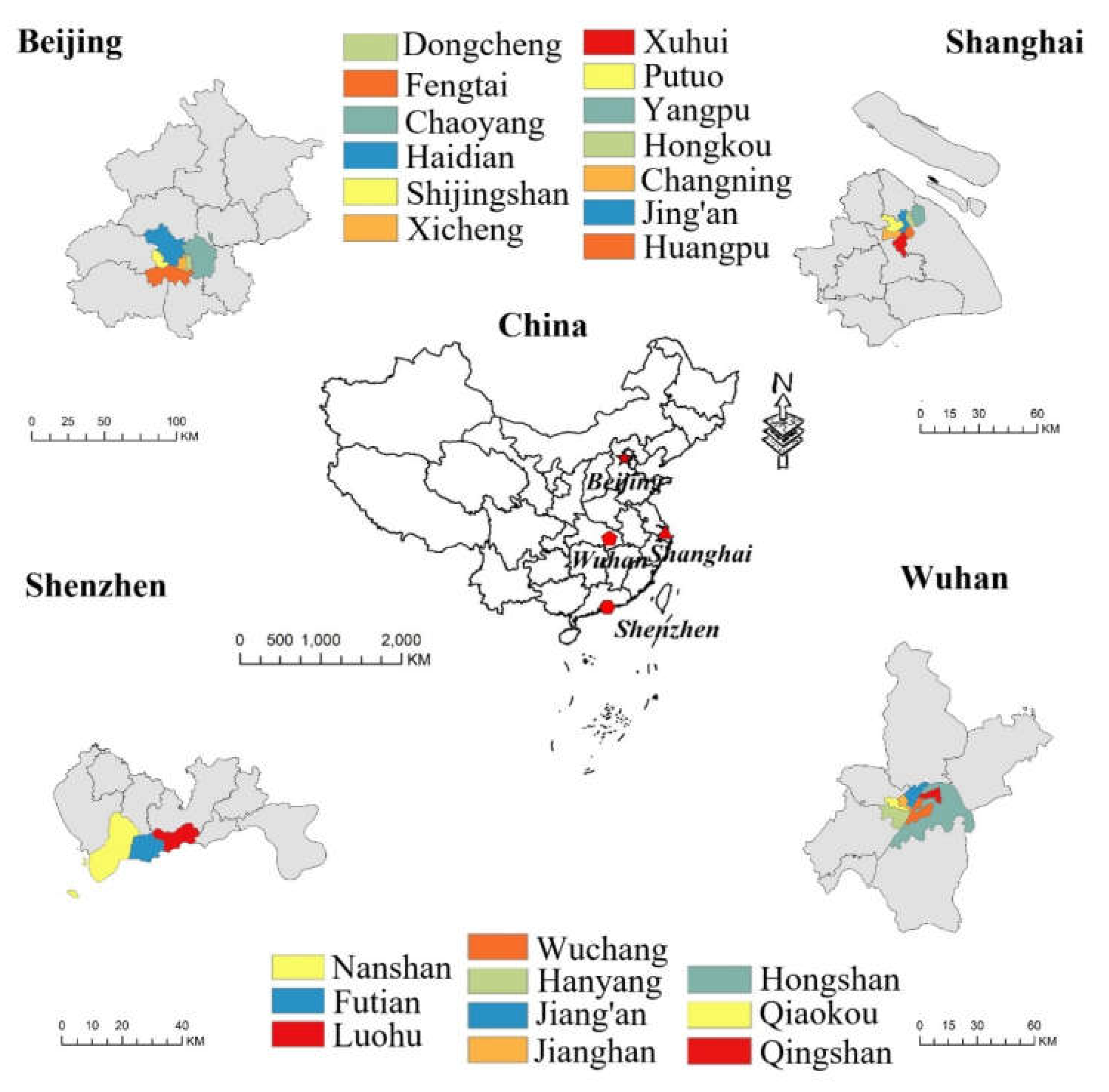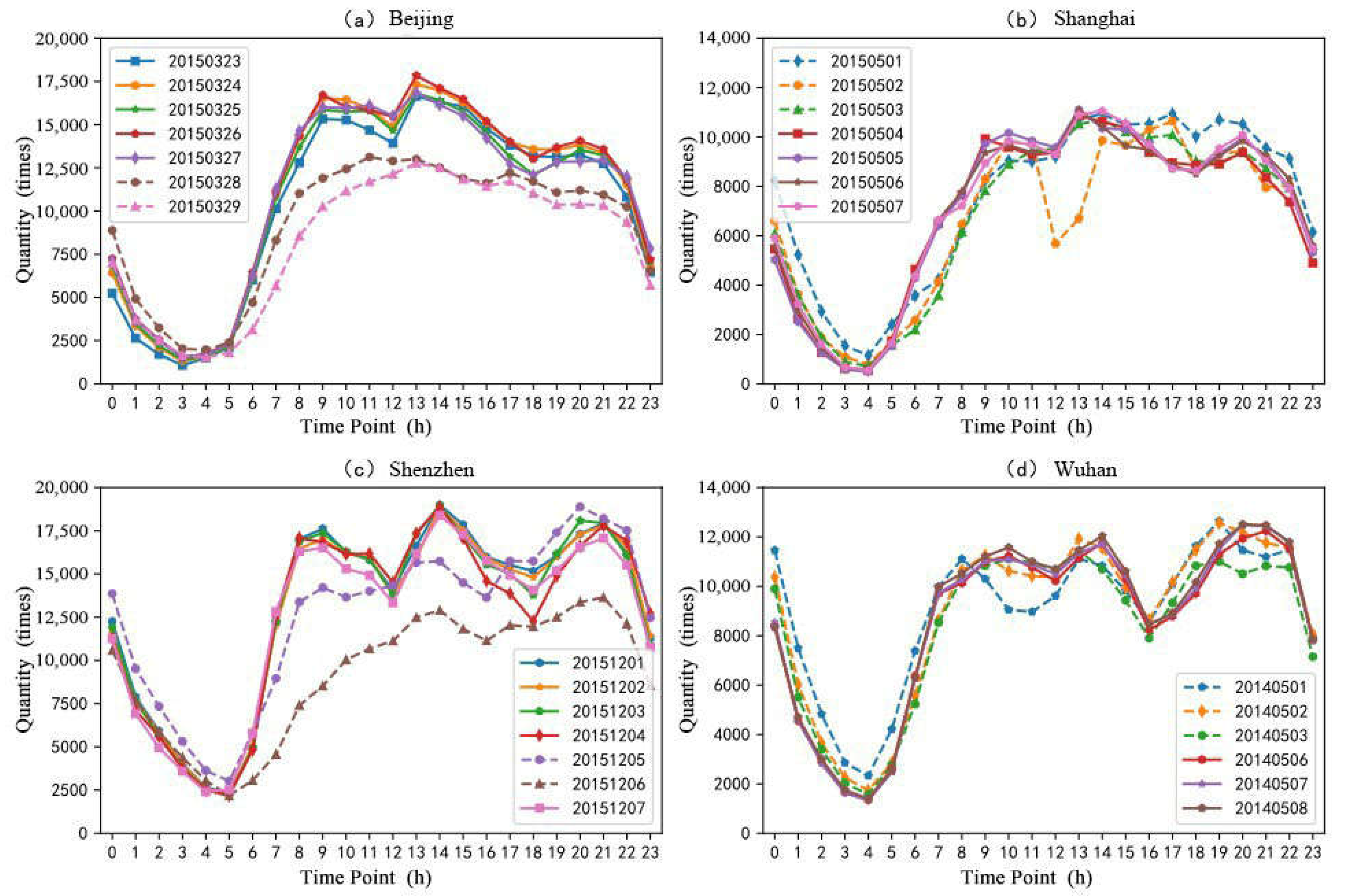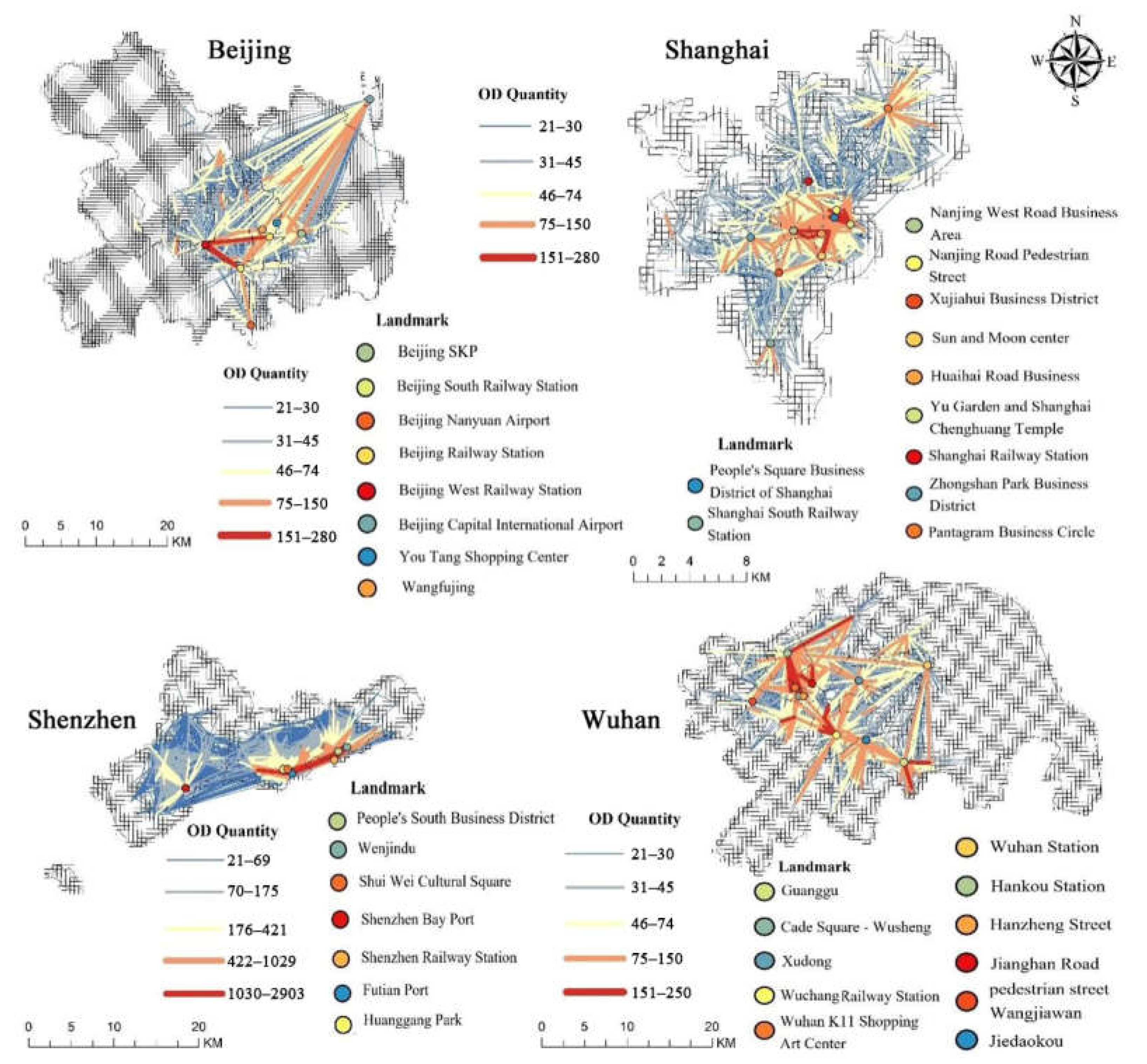Travel Characteristics of Urban Residents Based on Taxi Trajectories in China: Beijing, Shanghai, Shenzhen, and Wuhan
Abstract
1. Introduction
2. Materials and Methods
2.1. Study Area
2.2. Data
2.3. OLS
2.4. GWR
2.5. Model Evaluation Metric
3. Results
3.1. Temporal Trajectory Characteristics
3.2. Spatial Trajectory Characteristics
3.3. Trajectory and Urban Morphology Model Analysis
3.4. Comparison between the OLS and GWR Models
4. Discussion
5. Conclusions
- Temporal Characteristics: Shenzhen had the highest average daily travel volume, with Beijing and Wuhan following. Beijing and Shenzhen experienced more significant travel fluctuations compared to Shanghai and Wuhan.
- Spatial Characteristics: In all four cities, high interaction zones in vehicle boarding and deboarding were mostly found in commercial areas and near external transportation facilities, reflecting movement patterns between these locations.
- Travel Characteristics and Urban Morphology: The GWR model showed a better fit than the OLS model. The most significant influences on travel patterns were external transportation services and financial services, followed by medical care and catering services.
Author Contributions
Funding
Institutional Review Board Statement
Informed Consent Statement
Data Availability Statement
Conflicts of Interest
References
- Yin, H.; Zhang, Z.; Wan, Y.; Gao, Z.; Guo, Y.; Xiao, R. Sustainable network analysis and coordinated development simulation of urban agglomerations from multiple perspectives. J. Clean. Prod. 2023, 413, 137378. [Google Scholar] [CrossRef]
- Bock, F.; Di Martino, S.; Origlia, A. Smart parking: Using a crowd of taxis to sense on-street parking space availability. IEEE Trans. Intell. Transp. Syst. 2019, 21, 496–508. [Google Scholar] [CrossRef]
- Ge, W.; Shao, D.; Xue, M.; Zhu, H.; Cheng, J. Urban taxi ridership analysis in the emerging metropolis: Case study in Shanghai. Transp. Res. Procedia 2017, 25, 4916–4927. [Google Scholar] [CrossRef]
- Choi, K. The influence of the built environment on household vehicle travel by the urban typology in Calgary, Canada. Cities 2018, 75, 101–110. [Google Scholar] [CrossRef]
- Zhang, B.; Chen, S.; Ma, Y.; Li, T.; Tang, K. Analysis on spatiotemporal urban mobility based on online car-hailing data. J. Transp. Geogr. 2020, 82, 102568. [Google Scholar] [CrossRef]
- Delclòs-Alió, X.; Gutiérrez, A.; Miralles-Guasch, C. The urban vitality conditions of Jane Jacobs in Barcelona: Residential and smartphone-based tracking measurements of the built environment in a Mediterranean metropolis. Cities 2019, 86, 220–228. [Google Scholar] [CrossRef]
- Fu, X.; Xu, C.; Liu, Y.; Chen, C.H.; Hwang, F.J.; Wang, J. Spatial heterogeneity and migration characteristics of traffic congestion—A quantitative identification method based on taxi trajectory data. Phys. A Stat. Mech. Its Appl. 2022, 588, 126482. [Google Scholar] [CrossRef]
- Peng, Z.; Bai, G.; Wu, H.; Liu, L.; Yu, Y. Travel mode recognition of urban residents using mobile phone data and MapAPI. Environ. Plan. B Urban Anal. City Sci. 2021, 48, 2574–2589. [Google Scholar] [CrossRef]
- Yang, Z.; Franz, M.L.; Zhu, S.; Mahmoudi, J.; Nasri, A.; Zhang, L. Analysis of Washington, DC taxi demand using GPS and land-use data. J. Transp. Geogr. 2018, 66, 35–44. [Google Scholar] [CrossRef]
- Yan, L.; Sheng, B.; He, Y.; Lu, S.; Guo, J. Forecasting and Planning Method for Taxi Travel Combining Carbon Emission and Revenue Factors—A Case Study in China. Int. J. Environ. Res. Public Health 2022, 19, 11490. [Google Scholar] [CrossRef]
- Wu, Y.; Yao, Y.; Ren, S.; Zhang, S.; Guan, Q. How do urban services facilities affect social segregation among people of different economic levels? A case study of Shenzhen city. Environ. Plan. B Urban Anal. City Sci. 2023, 50, 1502–1517. [Google Scholar] [CrossRef]
- Gong, S.; Gao, Y.; Zhang, F.; Mu, L.; Kang, C.; Liu, Y. Evaluating healthcare resource inequality in Beijing, China based on an improved spatial accessibility measurement. Trans. GIS 2021, 25, 1504–1521. [Google Scholar] [CrossRef]
- Guo, P.; Sun, Y.; Chen, Q.; Li, J.; Liu, Z. The Impact of Rainfall on Urban Human Mobility from Taxi GPS Data. Sustainability 2022, 14, 9355. [Google Scholar] [CrossRef]
- Liu, Y.; Gao, X.; Yi, D.; Jiang, H.; Zhao, Y.; Xu, J.; Zhang, J. Investigating human travel patterns from an activity semantic flow perspective: A case study within the fifth ring road in beijing using taxi trajectory data. ISPRS Int. J. Geo-Inf. 2022, 11, 140. [Google Scholar] [CrossRef]
- Sun, M.; Xue, C.; Cheng, Y.; Zhao, L.; Long, Z. Analyzing spatiotemporal daily travel source carbon emissions based on taxi trajectory data. IEEE Access 2021, 9, 107012–107023. [Google Scholar] [CrossRef]
- Liu, Z.; Wan, L.; Guo, J.; Huang, F.; Feng, X.; Wang, L.; Ma, J. Ppru: A privacy-preserving reputation updating scheme for cloud-assisted vehicular networks. IEEE Trans. Veh. Technol. 2023, 1–16. [Google Scholar] [CrossRef]
- Guo, J.; Liu, Z.; Tian, S.; Huang, F.; Li, J.; Li, X.; Igorevich, K.K.; Ma, J. Tfl-dt: A trust evaluation scheme for federated learning in digital twin for mobile networks. IEEE J. Sel. Areas Commun. 2023, 41, 3548–3560. [Google Scholar] [CrossRef]
- Zhao, Z.Y.; Cao, Y.; Kang, Y.; Xu, Z.Y. Prediction of spatiotemporal evolution of urban traffic emissions based on taxi trajectories. Int. J. Autom. Comput. 2021, 18, 219–232. [Google Scholar] [CrossRef]
- Wang, H.; Zhao, D.; Cai, Y.; Meng, Q.; Ong, G.P. Taxi trajectory data based fast-charging facility planning for urban electric taxi systems. Appl. Energy 2021, 286, 116515. [Google Scholar] [CrossRef]
- Su, Y.; Liu, Z.; Chang, J.; Deng, Q.; Zhang, Y.; Liu, J.; Long, Y. Measuring accessibility to healthcare using taxi trajectories data: A case study of acute myocardial infarction cases in Beijing. Int. J. Health Policy Manag. 2023, 12, 6653. [Google Scholar] [CrossRef]
- Kan, Z.; Tang, L.; Kwan, M.P.; Ren, C.; Liu, D.; Li, Q. Traffic congestion analysis at the turn level using Taxis’ GPS trajectory data. Comput. Environ. Urban Syst. 2019, 74, 229–243. [Google Scholar] [CrossRef]
- He, F.; Yan, X.; Liu, Y.; Ma, L. A traffic congestion assessment method for urban road networks based on speed performance index. Procedia Eng. 2016, 137, 425–433. [Google Scholar] [CrossRef]
- Zang, J.; Jiao, P.; Liu, S.; Zhang, X.; Song, G.; Yu, L. Identifying Traffic Congestion Patterns of Urban Road Network Based on Traffic Performance Index. Sustainability 2023, 15, 948. [Google Scholar] [CrossRef]
- Hayes, A.F.; Cai, L. Using heteroskedasticity-consistent standard error estimators in OLS regression: An introduction and software implementation. Behav. Res. Methods 2007, 39, 709–722. [Google Scholar] [CrossRef] [PubMed]
- Wu, D. Spatially and temporally varying relationships between ecological footprint and influencing factors in China’s provinces Using Geographically Weighted Regression (GWR). J. Clean. Prod. 2020, 261, 121089. [Google Scholar] [CrossRef]
- Houlden, V.; de Albuquerque, J.P.; Weich, S.; Jarvis, S. A spatial analysis of proximate greenspace and mental wellbeing in London. Appl. Geogr. 2019, 109, 102036. [Google Scholar] [CrossRef]
- Mennis, J. Mapping the results of geographically weighted regression. Cartogr. J. 2006, 43, 171–179. [Google Scholar] [CrossRef]
- Brunsdon, C.; Fotheringham, A.S.; Charlton, M.E. Geographically weighted regression: A method for exploring spatial nonstationarity. Geogr. Anal. 1996, 28, 281–298. [Google Scholar] [CrossRef]
- Farber, S.; Páez, A. A systematic investigation of cross-validation in GWR model estimation: Empirical analysis and Monte Carlo simulations. J. Geogr. Syst. 2007, 9, 371–396. [Google Scholar] [CrossRef]
- Liu, C.; Wu, X.; Wang, L. Analysis on land ecological security change and affect factors using RS and GWR in the Danjiangkou Reservoir area, China. Appl. Geogr. 2019, 105, 1–14. [Google Scholar] [CrossRef]
- Tu, P.; Yao, W.; Zhao, Z.; Wang, P.; Wu, S.; Fang, Z. Interday Stability of Taxi Travel Flow in Urban Areas. ISPRS Int. J. Geo-Inf. 2022, 11, 590. [Google Scholar] [CrossRef]
- Wang, H.; Huang, H.; Ni, X.; Zeng, W. Revealing spatial-temporal characteristics and patterns of urban travel: A large-scale analysis and visualization study with taxi GPS data. ISPRS Int. J. Geo-Inf. 2019, 8, 257. [Google Scholar] [CrossRef]
- Zhang, Z.; Zhang, Y.; He, T.; Xiao, R. Urban vitality and its influencing factors: Comparative analysis based on taxi trajectory data. IEEE J. Sel. Top. Appl. Earth Obs. Remote Sens. 2022, 15, 5102–5114. [Google Scholar] [CrossRef]
- Yao, Y.; Wu, D.; Hong, Y.; Chen, D.; Liang, Z.; Guan, Q.; Liang, X.; Dai, L. Analyzing the effects of rainfall on urban traffic-congestion bottlenecks. IEEE J. Sel. Top. Appl. Earth Obs. Remote Sens. 2020, 13, 504–512. [Google Scholar] [CrossRef]
- Chen, X.J.; Wang, Y.; Xie, J.; Zhu, X.; Shan, J. Urban hotspots detection of taxi stops with local maximum density. Comput. Environ. Urban Syst. 2021, 89, 101661. [Google Scholar] [CrossRef]
- Mwale, M.; Luke, R.; Pisa, N. Factors that affect travel behaviour in developing cities: A methodological review. Transp. Res. Interdiscip. Perspect. 2022, 16, 100683. [Google Scholar] [CrossRef]
- Wu, W.; Yao, Y.; Wang, R. Green space exposure at subway stations, transportation mode choice and travel satisfaction. Transp. Res. Part D Transp. Environ. 2023, 122, 103862. [Google Scholar] [CrossRef]
- Zhang, F.; Wu, L.; Zhu, D.; Liu, Y. Social sensing from street-level imagery: A case study in learning spatio-temporal urban mobility patterns. ISPRS J. Photogramm. Remote Sens. 2019, 153, 48–58. [Google Scholar] [CrossRef]
- Li, Z.T.; Nie, W.P.; Cai, S.M.; Zhao, Z.D.; Zhou, T. Exploring the topological characteristics of urban trip networks based on taxi trajectory data. Phys. A Stat. Mech. Its Appl. 2023, 609, 128391. [Google Scholar] [CrossRef]
- He, B.; Liu, K.; Xue, Z.; Liu, J.; Yuan, D.; Yin, J.; Wu, G. Spatial and temporal characteristics of urban tourism travel by taxi—A case study of Shenzhen. ISPRS Int. J. Geo-Inf. 2021, 10, 445. [Google Scholar] [CrossRef]
- Du, J.; Meng, C.; Liu, X. Analysis of Urban Residents’ Travelling Characteristics and Hotspots Based on Taxi Trajectory Data. Appl. Sci. 2024, 14, 1279. [Google Scholar] [CrossRef]
- Li, B.; Cai, Z.; Jiang, L.; Su, S.; Huang, X. Exploring urban taxi ridership and local associated factors using GPS data and geographically weighted regression. Cities 2019, 87, 68–86. [Google Scholar] [CrossRef]
- Yin, H.; Xiao, R.; Fei, X.; Zhang, Z.; Gao, Z.; Wan, Y.; Tan, W.; Cao, W.; Guo, Y. Analyzing “Economy-Society-Environment” sustainability from the perspective of urban spatial structure: A case study of the Yangtze River Delta Urban Agglomeration. Sustain. Cities Soc. 2023, 96, 104691. [Google Scholar] [CrossRef]




| CS | FI | MS | ET | ||
|---|---|---|---|---|---|
| Beijing | Coefficient | 2.114 | 10.937 | 5.895 | 11.399 |
| t test statistic (t-Stat) | 28.709 | 32.645 | 28.874 | 38.650 | |
| VIF | 1.438 | 1.445 | 1.225 | 1.005 | |
| Adjusted R2 value | 0.593 | ||||
| Shanghai | Coefficient | 2.254 | 9.578 | 4.009 | 9.515 |
| t test statistic (t-Stat) | 25.609 | 12.5774 | 13.288 | 8.443 | |
| VIF | 1.892 | 1.898 | 1.138 | 1.002 | |
| Adjusted R2 value | 0.706 | ||||
| Shenzhen | Coefficient | 4.467 | 29.153 | 15.951 | 163.060 |
| t test statistic (t-Stat) | 14.225 | 18.969 | 12.743 | 36.050 | |
| VIF | 2.223 | 1.716 | 1.868 | 1.006 | |
| Adjusted R2 value | 0.734 | ||||
| Wuhan | Coefficient | 2.226 | 13.464 | 7.513 | 21.155 |
| t test statistic (t-Stat) | 27.524 | 20.170 | 23.391 | 28.524 | |
| VIF | 1.761 | 1.607 | 1.564 | 1.001 | |
| Adjusted R2 value | 0.618 | ||||
| Beijing | Shanghai | Shenzhen | Wuhan | |||||
|---|---|---|---|---|---|---|---|---|
| OLS | GWR | OLS | GWR | OLS | GWR | OLS | GWR | |
| R2 | 0.593 | 0.916 | 0.707 | 0.884 | 0.734 | 0.974 | 0.618 | 0.920 |
| Adjusted R2 | 0.593 | 0.888 | 0.706 | 0.861 | 0.734 | 0.957 | 0.618 | 0.881 |
| AICc | 9010.855 | 6051.826 | 2105.353 | 1400.552 | 2479.490 | 852.302 | 7794.457 | 5301.455 |
| Bandwidth | - | 605.210 | - | 917.480 | - | 427.260 | - | 468.330 |
Disclaimer/Publisher’s Note: The statements, opinions and data contained in all publications are solely those of the individual author(s) and contributor(s) and not of MDPI and/or the editor(s). MDPI and/or the editor(s) disclaim responsibility for any injury to people or property resulting from any ideas, methods, instructions or products referred to in the content. |
© 2024 by the authors. Licensee MDPI, Basel, Switzerland. This article is an open access article distributed under the terms and conditions of the Creative Commons Attribution (CC BY) license (https://creativecommons.org/licenses/by/4.0/).
Share and Cite
Chang, X.; Chen, H.; Li, J.; Fei, X.; Xu, H.; Xiao, R. Travel Characteristics of Urban Residents Based on Taxi Trajectories in China: Beijing, Shanghai, Shenzhen, and Wuhan. Sustainability 2024, 16, 2694. https://doi.org/10.3390/su16072694
Chang X, Chen H, Li J, Fei X, Xu H, Xiao R. Travel Characteristics of Urban Residents Based on Taxi Trajectories in China: Beijing, Shanghai, Shenzhen, and Wuhan. Sustainability. 2024; 16(7):2694. https://doi.org/10.3390/su16072694
Chicago/Turabian StyleChang, Xueli, Haiyang Chen, Jianzhong Li, Xufeng Fei, Haitao Xu, and Rui Xiao. 2024. "Travel Characteristics of Urban Residents Based on Taxi Trajectories in China: Beijing, Shanghai, Shenzhen, and Wuhan" Sustainability 16, no. 7: 2694. https://doi.org/10.3390/su16072694
APA StyleChang, X., Chen, H., Li, J., Fei, X., Xu, H., & Xiao, R. (2024). Travel Characteristics of Urban Residents Based on Taxi Trajectories in China: Beijing, Shanghai, Shenzhen, and Wuhan. Sustainability, 16(7), 2694. https://doi.org/10.3390/su16072694






